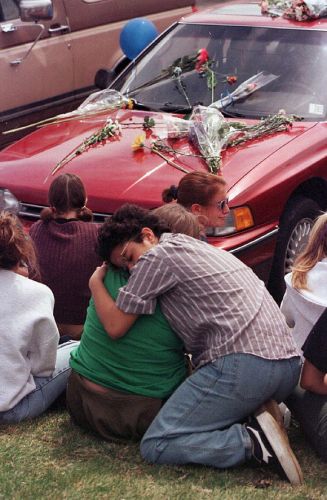 There are very few news stories that have affected me as deeply as the massacre at Columbine High School. Obviously, Sept. 11 hit the whole country. It still stands as an event that I cannot even comprehend. But for me as someone who lived on that side of Denver for a decade, Columbine remains a kind of small-scale, very personal, horror that stands alone.
Looking back, it is hard to believe that many people tried to tone down the religion element of this complex story. This story was more than the story of one or two or three young people who were gunned down after they confessed their faith. There was more to this than debates about what is and what is not martyrdom.
There are very few news stories that have affected me as deeply as the massacre at Columbine High School. Obviously, Sept. 11 hit the whole country. It still stands as an event that I cannot even comprehend. But for me as someone who lived on that side of Denver for a decade, Columbine remains a kind of small-scale, very personal, horror that stands alone.
Looking back, it is hard to believe that many people tried to tone down the religion element of this complex story. This story was more than the story of one or two or three young people who were gunned down after they confessed their faith. There was more to this than debates about what is and what is not martyrdom.
In that video made before their rampage, Eric Harris and Dylan Klebold talked about starting a "religious war" and mocked an outspoken Christian girl named Rachel. In audio tapes aired on CNN, and transcripts released by parents, Klebold said: "Stuck-up little b---- , you f------ little Christianity, godly little w----."
Harris: "Yeah, 'I love Jesus, I love Jesus.' ... Shut the f--- up."
Klebold: "What would Jesus do? What would I do? (Makes shotgun sound at camera)"
"Rachel," of course, must have been Rachel Joy Scott, who wrote in her personal journal -- precisely one year before the tragedy -- these words: "I have no more personal friends at school. But you know what? I am not going to apologize for speaking the name of Jesus, I am not going to justify my faith to them, and I am not going to hide the light that God has put into me. If I have to sacrifice everything I will. I will take it."
There's so, so, so much more to this story, of course. But all of that came back the other day as I read Stephanie Simon's news feature in the Los Angeles Times about the dedication of the new memorial near the high school. It has all the small details that you would expect:
Cut into the hillside, the memorial features two curving walls of rough red sandstone. The outer wall is engraved with remarks from the community about that day. The inner wall supports 13 granite slabs, each inscribed with a victim's name and a message from the family.
It's a beautiful place. Wind rustles golden trees. Laughter drifts from a nearby playground. ...
Cassie Bernall longed to know heaven. Lauren Townsend wrote in her diary: "I am not afraid of death for it is only a transition." John Tomlin lost his faith for some time, then reconnected, with great joy. Rachel Scott's killers asked if she believed in God. Her final words: "You know I do!" ...
The victims of Columbine were regular kids, and that's how they are honored here. They asked annoying questions, failed to make the soccer team, were obsessed with Chevy trucks -- and the Packers. They struggled with depression. They liked ice cream.
The GetReligionistas love Simon's work, as a rule. But this story is almost too nice.
You really wouldn't know, unless you followed the coverage through the year, how hard it was to cross the tricky church-state territory surrounding that killing field. There were debates about memorial services. There were debates about civic prayers. There were debates about religious expressions in memorial tiles inside the school. Could you use crosses in a civic memorial? The debates were painful, but that was to be expected.
Simon says that there were complex issues linked to the memorial, but keeps things gentle.
Talk of a memorial began soon after the last funeral. But families of the victims wanted to focus first on rebuilding the school library, where Dylan Klebold and Eric Harris targeted several classmates, then turned their guns fatally on themselves.
It would be nearly four years before parents, teachers and civic leaders agreed on a memorial design. It took another four years to come up with $1.5 million for construction.
This is part of the story and a very beautiful part. But, sadly, we live in a day and age when it is even hard to mourn without battles over freedom of religion. I have no idea how you cover this story now, without focusing on the divisions as well as the unity.
